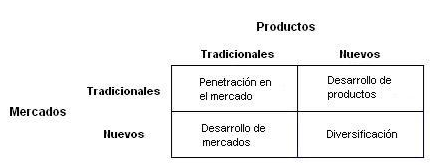THE ANSOFF MATRIX. PRODUCT/MARKET MATRIX OR GROWTH VECTOR
Accelerate your business with these expert tips on "The Ansoff Matrix, Product/Market Matrix or Growth Vector". Analyse and discover this TIP!
The Ansoff matrix, also known as the Product/Market Matrix or Growth Vector, created by Igor Ansoff in 1957 1 is used for identify growth opportunities in the business units of an organisation. In other words, it expresses the possible product/market combinations (or business units) on which the company can base its future development.
This matrix describes the different strategic options, positioning them according to the analysis of the main components of the strategic problem or factors that define it.
The Ansoff Matrix is a strategic tool that provides a structured framework for thinking about how a company can grow, through either existing market penetration, new market development, new product development, or diversification.

Let's look at how an entrepreneur could apply each of these strategies:
INDEX
- Market penetration.
- Market development.
- Product development.
- Diversification.
MARKET PENETRATION
OBJECTIVE:
- Increase sales of current products in current markets.
MAIN STRATEGIES:
- Build more loyalty with existing customers, perhaps through loyalty programmes.
- Steal market share from the competition, perhaps through a more competitive pricing strategy.
EXAMPLE:
- Let's say you run a coffee shop. You could offer a loyalty card that offers a free drink after 10 purchases to encourage repeat purchases.
MARKET DEVELOPMENT
OBJECTIVE:
- Selling existing products in new markets.
MAIN STRATEGIES:
- Opening up new geographic markets.
- Use of new distribution channels, such as an online shop.
EXAMPLE:
- If the entrepreneur has a successful clothing shop in one city, he/she could consider opening a new location in another city or even sell online to reach a wider market.
PRODUCT DEVELOPMENT
OBJECTIVE:
- Selling new products or services in the current market.
MAIN STRATEGIES:
- Introduction of new product variants.
- Improve the quality or performance of the existing product.
EXAMPLE:
- If the entrepreneur has an electronics shop, he/she could start offering related accessories such as mobile phone cases or headsets.
DIVERSIFICATION
OBJECTIVE:
- Enter new markets with new products.
MAIN STRATEGIES:
- Related diversification: moving into new markets where the company can apply its technical competence or marketing know-how.
- Unrelated diversification: entering a business that is unrelated to the current business.
EXAMPLE:
- An entrepreneur who has been successful in a fitness chain could diversify into the health food market by creating or acquiring a low-calorie ready meal business.
IN SUMMARY
The Ansoff Matrix offers a systematic approach for addressing growth and expansion. Understanding each of the four strategies, an entrepreneur can make a more comprehensive analysis of growth opportunities and decide which is most appropriate for his or her business.
APPLY THIS TIP TO YOUR PROJECT
TASK
Now that you have read the TIP, answer this question:
- What is the Ansoff Matrix for?
CASE STUDY: ANA AND HER HANDMADE JEWELLERY BUSINESS "GEMARTE".
Ana is an entrepreneur who has created a small but successful handmade jewellery business. She has been selected for an accelerator programme and wants to use this opportunity to scale her business. After being introduced to the Ansoff Matrix during the programme, Ana decides to use it to plan her growth strategy.
INITIAL ANALYSIS
Ana currently sells her jewellery through an online shop and a small stall in a local market. Her clientele consists mainly of local people and tourists who visit the market.
MARKET PENETRATION:
- Objective: increase sales among existing and local customers.
- Strategies:
- Implement a loyalty programme to encourage repeat purchases.
- Special offers during local holidays to attract more traffic.
- Actions:
- Ana decides to launch a digital loyalty card offering a 10% discount after the third purchase.
MARKET DEVELOPMENT:
- Objective: expanding sales to new cities and communities.
- Strategies:
- Participate in fairs and markets in other cities.
- Improve the SEO of your online shop to attract a wider audience.
- Actions:
- Ana researches craft fairs in nearby cities and registers for three of them for the next six months.
PRODUCT DEVELOPMENT:
- Objective: introduce new products that appeal to their existing market.
- Strategies:
- Introduce a new line of jewellery with semi-precious stones.
- Offer customisation options.
- Actions:
- Ana designs a new collection incorporating semi-precious stones and announces the option of personalisation in her online shop.
DIVERSIFICATION
- Objective: start a new line of related but distinct products.
- Strategies:
- Create a line of home accessories made from the same materials as your jewellery.
- Actions:
- Ana experiments with creating home decorations, such as dream catchers and small art objects.
Ana presents her plan during the final phase of the acceleration programme, receiving good feedback and some additional suggestions. She feels more confident and prepared to take her business to the next level thanks to the strategic application of the Ansoff Matrix. With this approach, Ana is leveraging multiple avenues for growth and minimising risks by diversifying her strategies.
ARTIFICIAL INTELLIGENCE CAN BE A VALUABLE TOOL FOR APPLYING THE ANSOFF MATRIX IN A VARIETY OF WAYS:
MARKET RESEARCH AND ANALYSIS
Assist in the collection of data on different markets, competitors and trends that are relevant to decisions in each quadrant of the matrix.
IDEA GENERATION
Offer creative suggestions for new products, marketing strategies or areas of expansion that could fit into each of the four quadrants (Market Penetration, Market Development, Product Development and Diversification).
IMPLEMENTATION STRATEGIES
Propose specific methods to implement each strategy, such as digital marketing tactics for market penetration or business plans for diversification.
RISK ASSESSMENT
Help identify potential risks in each quadrant and propose measures to mitigate them.
VALIDATION OF IDEAS
Facilitate the process of validating ideas by generating questions or criteria to be considered.
COMMUNICATION AND PRESENTATION
Assist in preparing presentations, reports or papers that explain and justify the strategies selected in the Ansoff Matrix.
TRAINING AND CAPACITY BUILDING
Serve as an educational tool to teach team members or stakeholders about the Ansoff Matrix and how it is applied in strategic decision making.
TASK AUTOMATION
For example, you can automate the sending of customer surveys to collect data for use in market penetration analysis.
CONTINUED SUPPORT
Offer advice and suggestions on an ongoing basis during the implementation of the strategy, serving as a kind of "digital consultant".
By using artificial intelligence in this way, you can make the process of applying the Ansoff Matrix more efficient, informed and creative.
QUIZ
- 💻 PRACTICE with an expert in the next practical webinar.
- 🔎 CONSULT more related TIPs with this same theme.
- 📖 AMPLIA your knowledge by downloading this EBOOK.
THINK ABOUT YOU
- 🚀 IMPULSA your company in the next acceleration programme, ¡book your place now!
- 🥁 PRACTICE with your project in this practical webinar, ¡apply for your place!
- 🌐 CONTACT with other entrepreneurs and companies, ¡register and take part in the next Networking!
THINK ABOUT HELPING OTHERS
- 🤝COLLABORATE as a volunteer: expert, mentor, inverter, awarding, Spreading the word, challenging, innovating, creating a TIP...
- 💬 RECOMMENDS this programme to reach out to more entrepreneurs by Google.
- 👉 SHARE your learning!
- 📲 SEND this TIP 👇









